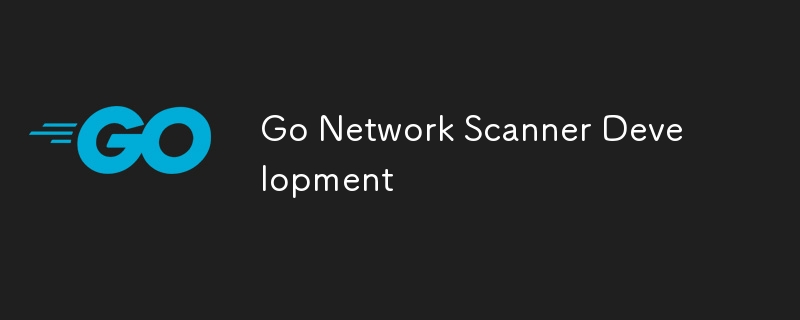There are four core points to develop a Go network scanner: 1. Select suitable libraries such as net and gopacket; 2. Understand the underlying protocols such as ICMP, TCP, SYN, and UDP; 3. Use goroutine and channel to design concurrency mechanisms and control quantity; 4. Ensure scanning compliance to avoid abuse. The basic methods of network scanning include ICMP detection host survival, TCP/SYN/UDP port detection, etc. Go's net library can implement basic scanning, and gopacket supports original packet operation. Efficiency can be improved by limiting the number of goroutines combined with WaitGroup and buffered channels. Notes include legal authorization, rate control, avoiding large-scale public network scanning, and providing disclaimers to ensure compliance.

If you plan to develop a Go network scanner, there are several core points to grasp: selecting the right library, understanding the underlying protocol, designing a reasonable concurrency mechanism, and ensuring compliance with scanning behavior. This is not just a matter of writing a few lines of code, but a certain understanding of network communication and performance optimization.

The basic way to scan the network
The core of network scanning is to detect whether the target host survives, which ports are opened, what services are running, etc. Common scanning methods include:
- ICMP scan : determine whether the host is online by sending an ICMP Echo request.
- TCP scan : Try to establish a TCP connection with the target port to determine whether the port is open.
- SYN scan (half-open scan) : Send SYN packets and listen for responses, without completing three handshakes, it is more concealed.
- UDP scanning : It is suitable for UDP service detection, but it is not very stable due to the high packet loss rate.
To implement these functions in Go, you can use net standard library for basic operations, such as net.DialTimeout to implement TCP scanning. If you want to have a more underlying control, such as constructing original data packets, you need to use third-party libraries such as gopacket or afpacket .

Using the concurrency advantages of Go to improve efficiency
One of Go's biggest advantages is its concurrency model. High-performance scanners can be easily implemented with goroutine and channel.
To give a simple example: if you want to scan multiple ports of an IP, you can perform the detection task of each port as a goroutine and pass the results back through the channel. This can greatly improve the scanning speed and the code structure is also clear.

However, it should be noted that the number of goroutines cannot grow unlimitedly, otherwise it may cause resource exhaustion or banned by the target system. It is recommended to use sync.WaitGroup and buffered channel to control the concurrency number.
You can do this:
- Define a maximum number of concurrencies, such as 100
- Use a buffered channel as the semaphore
- Every time a goroutine is started, a "license" is obtained from the channel and released after completion.
Library selection and usage suggestions
The Go community already has some good network scanning related libraries. Here are a few commonly used recommendations:
-
net: Standard library, suitable for TCP/UDP basic scanning. -
gopacket: is used to process raw network packets, suitable for advanced scanning (such as SYN scanning). -
masscanbinding library : If you need the ultimate scanning speed, you can consider encapsulating masscan tools. -
nmapcalling interface : If you don't want to recreate the wheel, you can directly call the nmap command and parse the output.
Which library to choose depends on your needs. If you are just making a small intranet scanning tool, using net is enough; if you want to make an enterprise-level scanner, you may need to use gopacket to build a complete custom protocol stack.
Precautions and compliance issues
When developing network scanners, in addition to technical issues, you should also pay attention to the following points:
- Do not enable "Silent Mode" or "Hide Scan Traces" by default. Legal use is the most important thing.
- Avoid large-scale public network scanning and prevent being mistaken for attacks.
- Add delay or rate control options to the program to avoid triggering firewall rules.
- Provide clear user prompts that the tool is only available within the scope of authorization.
Many security tools are held accountable due to abuse, so you must add a disclaimer before publishing and encourage users to abide by laws and regulations.
Basically that's it. Go is a language that is very suitable for writing network tools, but although it is not technically difficult to develop network scanners, there are still many details that need to be paid attention to in actual applications.
The above is the detailed content of Go Network Scanner Development. For more information, please follow other related articles on the PHP Chinese website!

Hot AI Tools

Undress AI Tool
Undress images for free

Undresser.AI Undress
AI-powered app for creating realistic nude photos

AI Clothes Remover
Online AI tool for removing clothes from photos.

Clothoff.io
AI clothes remover

Video Face Swap
Swap faces in any video effortlessly with our completely free AI face swap tool!

Hot Article

Hot Tools

Notepad++7.3.1
Easy-to-use and free code editor

SublimeText3 Chinese version
Chinese version, very easy to use

Zend Studio 13.0.1
Powerful PHP integrated development environment

Dreamweaver CS6
Visual web development tools

SublimeText3 Mac version
God-level code editing software (SublimeText3)
 How to handle transactions in Java with JDBC?
Aug 02, 2025 pm 12:29 PM
How to handle transactions in Java with JDBC?
Aug 02, 2025 pm 12:29 PM
To correctly handle JDBC transactions, you must first turn off the automatic commit mode, then perform multiple operations, and finally commit or rollback according to the results; 1. Call conn.setAutoCommit(false) to start the transaction; 2. Execute multiple SQL operations, such as INSERT and UPDATE; 3. Call conn.commit() if all operations are successful, and call conn.rollback() if an exception occurs to ensure data consistency; at the same time, try-with-resources should be used to manage resources, properly handle exceptions and close connections to avoid connection leakage; in addition, it is recommended to use connection pools and set save points to achieve partial rollback, and keep transactions as short as possible to improve performance.
 Python for Data Engineering ETL
Aug 02, 2025 am 08:48 AM
Python for Data Engineering ETL
Aug 02, 2025 am 08:48 AM
Python is an efficient tool to implement ETL processes. 1. Data extraction: Data can be extracted from databases, APIs, files and other sources through pandas, sqlalchemy, requests and other libraries; 2. Data conversion: Use pandas for cleaning, type conversion, association, aggregation and other operations to ensure data quality and optimize performance; 3. Data loading: Use pandas' to_sql method or cloud platform SDK to write data to the target system, pay attention to writing methods and batch processing; 4. Tool recommendations: Airflow, Dagster, Prefect are used for process scheduling and management, combining log alarms and virtual environments to improve stability and maintainability.
 Comparing Java Frameworks: Spring Boot vs Quarkus vs Micronaut
Aug 04, 2025 pm 12:48 PM
Comparing Java Frameworks: Spring Boot vs Quarkus vs Micronaut
Aug 04, 2025 pm 12:48 PM
Pre-formanceTartuptimeMoryusage, Quarkusandmicronautleadduetocompile-Timeprocessingandgraalvsupport, Withquarkusoftenperforminglightbetterine ServerLess scenarios.2.Thyvelopecosyste,
 How does garbage collection work in Java?
Aug 02, 2025 pm 01:55 PM
How does garbage collection work in Java?
Aug 02, 2025 pm 01:55 PM
Java's garbage collection (GC) is a mechanism that automatically manages memory, which reduces the risk of memory leakage by reclaiming unreachable objects. 1.GC judges the accessibility of the object from the root object (such as stack variables, active threads, static fields, etc.), and unreachable objects are marked as garbage. 2. Based on the mark-clearing algorithm, mark all reachable objects and clear unmarked objects. 3. Adopt a generational collection strategy: the new generation (Eden, S0, S1) frequently executes MinorGC; the elderly performs less but takes longer to perform MajorGC; Metaspace stores class metadata. 4. JVM provides a variety of GC devices: SerialGC is suitable for small applications; ParallelGC improves throughput; CMS reduces
 Comparing Java Build Tools: Maven vs. Gradle
Aug 03, 2025 pm 01:36 PM
Comparing Java Build Tools: Maven vs. Gradle
Aug 03, 2025 pm 01:36 PM
Gradleisthebetterchoiceformostnewprojectsduetoitssuperiorflexibility,performance,andmoderntoolingsupport.1.Gradle’sGroovy/KotlinDSLismoreconciseandexpressivethanMaven’sverboseXML.2.GradleoutperformsMaveninbuildspeedwithincrementalcompilation,buildcac
 go by example defer statement explained
Aug 02, 2025 am 06:26 AM
go by example defer statement explained
Aug 02, 2025 am 06:26 AM
defer is used to perform specified operations before the function returns, such as cleaning resources; parameters are evaluated immediately when defer, and the functions are executed in the order of last-in-first-out (LIFO); 1. Multiple defers are executed in reverse order of declarations; 2. Commonly used for secure cleaning such as file closing; 3. The named return value can be modified; 4. It will be executed even if panic occurs, suitable for recovery; 5. Avoid abuse of defer in loops to prevent resource leakage; correct use can improve code security and readability.
 Using HTML `input` Types for User Data
Aug 03, 2025 am 11:07 AM
Using HTML `input` Types for User Data
Aug 03, 2025 am 11:07 AM
Choosing the right HTMLinput type can improve data accuracy, enhance user experience, and improve usability. 1. Select the corresponding input types according to the data type, such as text, email, tel, number and date, which can automatically checksum and adapt to the keyboard; 2. Use HTML5 to add new types such as url, color, range and search, which can provide a more intuitive interaction method; 3. Use placeholder and required attributes to improve the efficiency and accuracy of form filling, but it should be noted that placeholder cannot replace label.
 go by example http middleware logging example
Aug 03, 2025 am 11:35 AM
go by example http middleware logging example
Aug 03, 2025 am 11:35 AM
HTTP log middleware in Go can record request methods, paths, client IP and time-consuming. 1. Use http.HandlerFunc to wrap the processor, 2. Record the start time and end time before and after calling next.ServeHTTP, 3. Get the real client IP through r.RemoteAddr and X-Forwarded-For headers, 4. Use log.Printf to output request logs, 5. Apply the middleware to ServeMux to implement global logging. The complete sample code has been verified to run and is suitable for starting a small and medium-sized project. The extension suggestions include capturing status codes, supporting JSON logs and request ID tracking.






